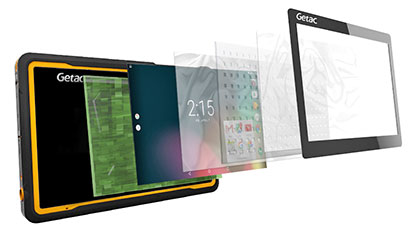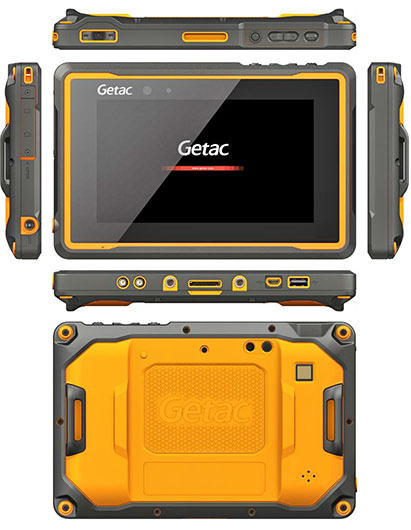What hasn't changed: The display still measures 7.0 inches diagonally and has 1280 x 720 pixel resolution. That means 210 ppi (pixels per inch), about as sharp as Apple's desktop "retina" 4k/5k iMac displays. The display uses IPS (in-plane switching) technology, which means a rock-steady picture with virtually perfect viewing angles from all directions and no brightness, color or contrast fluctuations.

The display uses Getac's LumiBond 2.0 technology that bonds Corning Gorilla Glass, the touch sensor and the LCD for optimal durability and readability. Luminance is rated at 580 nits — at the high end of modern smartphones and tablets. At a time where there are 6.5 and even 7-inch smartphones, most small tablets have migrated to 8 inches and more, but Android was designed for small displays, and so Getac decided to stay with the 7-inch format.
The 3.5mm hard-tip stylus remains the same. It offers precise operation. And touch sensitivity can be optimized for finger touch (even in the rain), stylus or gloves.
There also was no need to change the ZX70 platform's elegant and very functional design with its backside reminiscent of the SnapBack system first seen on the Getac T800 G2. There are hooks designed for easy attach and release of hand straps and a kick stand. Below you can see what the Getac ZX70 G2 looks like from all sides.

The tablet has a compact 8.6 x 5.6 inch footprint, significantly smaller than a standard iPad. It is about 1.1 inches thick, and weighs 1.7 pounds. Given ARM processor's efficiency, the 32 watt-hour Li-Ion battery should provide ample battery runtime.
Switching from the Intel Atom X5-Z8350 chip in the original ZX70 to the octa-core Qualcomm Snapdragon SD660 should provide a very substantial bump in performance. The SD660 was designed to pack the punch smartphone customers required from a high-end phone into a tightly integrated module. We've benchmarked this chip in a few other rugged handhelds and tablets, and it's definitely at the very forefront of what's available in Android-based rugged computing gear today. There's 64GB of onboard eMMC mass storage, twice of what came with the original, and that can be augmented via microSD card. RAM is up from 3GB to 4GB of LPDDR4 RAM.
As far as communications capabilities go, there's an upgrade to dual band 802.11ac WiFi and Bluetooth v5.0. As before there is optional 4G WWAN, as well as an optional LED or laser barcode reader, HF RFID/NFC, and discrete GPS. Note that none of these options are mutually exclusive with the exception of the UHF version of RFID that cannot be combined with 4G LTE or a barcode reader.
The tablet has dual cameras. The front one receives a significant bump from 2 megapixel to 8, the rear autofocus camera goes from 8 to 12mp. There are USB host and client ports and dual external antenna ports. The ZX70 includes an e-compass and G-sensor, and likely several other sensors as well.
On the ruggedness side, the ZX70 G2 can handle 6-foot drops, has a very wide operating temperature range of -6° to +140° degrees Fahrenheit (-21°C to +60° Celsius), and carries IP67 sealing, where the "6" stands for protection against full immersion down to about three feet for 30 minutes. Getac claims compliance with all relevant MIL-STD-810G/810H test. For use in hazardous locations, an ATEX / IECEx certified version of the original ZX70 was available. We assume that will be the case for the second gen version as well.
The Getac ZX70 G2 runs Android, the OS literally billions of people are familiar with. In the past, Google's rapid release of Android versions that were not always upgradeable and had user interfaces just different enough to confuse users was an issue. The original ZX70 started with Android 5.1, and later became available with Android 6.0 and 7.1. The second gen version comes with Android 9.0 "Pie" that brings substantial increases in security and enterprise functionality.
With Android the de facto standard in handhelds and small tablets, the very rugged and substantially more powerful Getac ZX70 G2 should be well received. -- Conrad H. Blickenstorfer, March 2020












